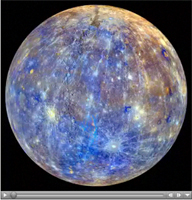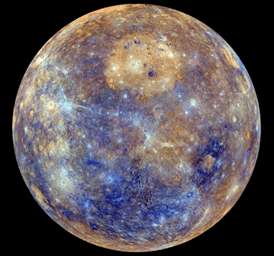
Click on the image for the animationClick here to watch a small version (6.5 MB) of this movie
Click here to watch full-size version (23 MB) of this movie
This is a still image taken from a rotating movie of Mercury's globe. A global color map of Mercury's surface has been created by mosaicking thousands of sets of images obtained by the MESSENGER Wide Angle Camera (WAC). The colors shown here are related to variations in the spectral reflectance across the planet. This view captures both compositional differences and differences in how long materials have been exposed at Mercury's surface. Young crater rays, arrayed radially around fresh impact craters, appear light blue or white. Medium- and dark-blue areas are a geologic unit of Mercury's crust known as the "low-reflectance material," thought to be rich in a dark, opaque mineral. Tan areas are plains formed by eruption of highly fluid lavas. The large circular area near the top center is the Caloris impact basin, whose interior is filled with smooth, somewhat younger volcanic plains. Small orangish spots are materials deposited by explosive volcanic eruptions.
The color base map shown here consists of MDIS images taken through eight different color filters. It is part of a global color map that covers more than 99% of Mercury's surface with an average resolution of about 1 kilometer per pixel.
Instrument: Wide Angle Camera (WAC) of the Mercury Dual Imaging System (MDIS). This is an enhanced-color presentation created from a statistical combination of images taken through eight of the WAC filters.
The MESSENGER spacecraft is the first ever to orbit the planet Mercury, and the spacecraft's seven scientific instruments and radio science investigation are unraveling the history and evolution of the Solar System's innermost planet. Visit the Why Mercury? section of this website to learn more about the key science questions that the MESSENGER mission is addressing. During the one-year primary mission, MDIS acquired 88,746 images and extensive other data sets. MESSENGER is now in a year-long extended mission, during which plans call for the acquisition of more than 80,000 additional images to support MESSENGER's science goals.
For information regarding the use of images, see the MESSENGER image use policy.

 Planetary Data System
Planetary Data System













